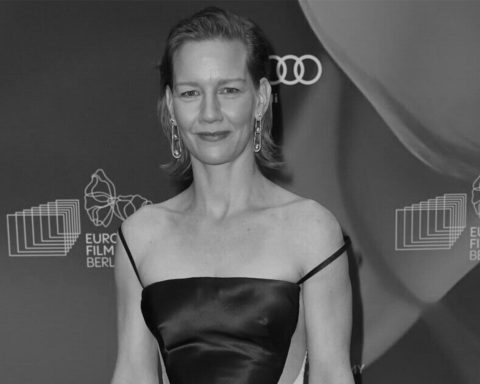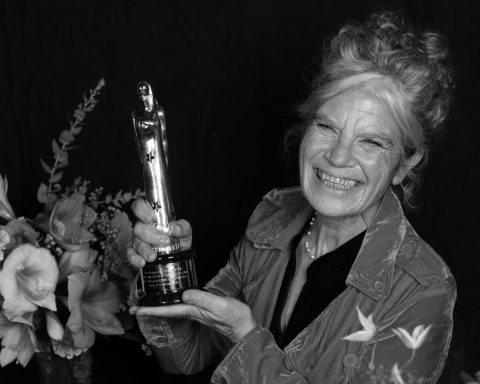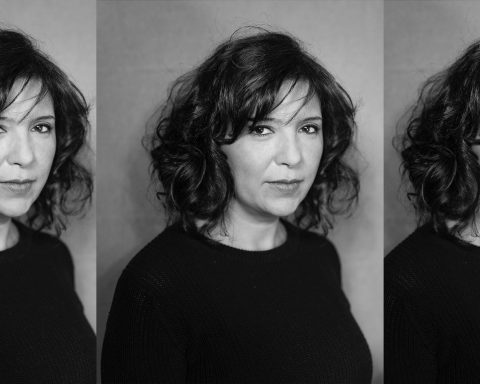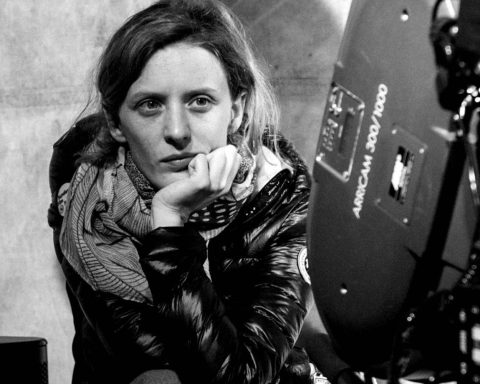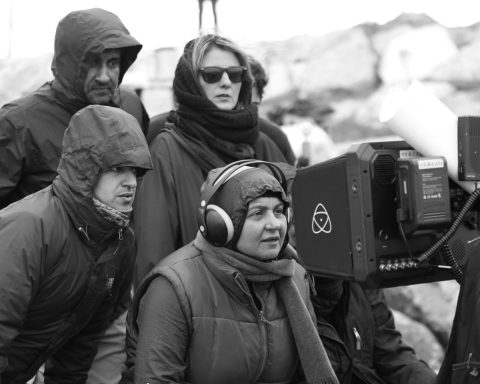Born in Geneva, Switzerland, Carmen Jaquier studied Graphic Design before making her first short film “Eat me!” and entering the Cantonal School of Art in Lausanne (ECAL). Her graduation film, “The Girls’ Grave,” received the Pardino d’argento at the 2011 Locarno Film Festival. She then explored Image and Editing within the Aamen collective. Her films “The River Under The Tongue” and “Wonderland” (collective feature film), were selected at the 2015 Locarno Film Festival. She also worked as DoP on a few films from artist Nagi Gianni, and on “A Bright Light – Karen and the Process” by Emmanuelle Antille, presented at the Visions du Réel Film Festival in 2018.
Tara Karajica talks to Carmen Jaquier about feminism and film and her debut feature, “Thunder,” an elemental portrayal of youth caught between restriction and discovery, desire and God, in which the magnificent Swiss landscape provides the setting for a young nun’s sexual awakening upon her return home to investigate her sister’s mysterious death. The film premiered at the 2022 Toronto International Film Festival, and is now screening in the Europe! Voices of Women in Film program at this year’s Sydney Film Festival. Carmen Jaquier was also recently presented with the 2023 Women in Motion Emerging Talent Award by Kering at the Cannes Film Festival.
How did you get into filmmaking?
Carmen Jaquier: I think I first started listening to a lot of stories and to write when I was a kid. When I was a teenager, I started writing scripts, but I was just copying films that I was watching. I also went to a school where I learned graphic design. So, I worked a lot with photography and I drew and even painted. It was a step-by-step process. I think it came from visual experimentations first, but that was really before my twenties. And then, I think there was really the first short film I made with friends, with a lot of freedom and just this realization that you can combine the sound, the image, the storytelling and the writing and I think, for me, it was a really joyful moment. I had a team, and it was the first time I experimented with the camera, with editing and with the actors even if they were friends.
How did Thunder come about?
C.J.: I have this relationship with Catholicism, Jesus Christ and God. When I was a kid and a teenager, I was really interested in stories about Jesus Christ. I don’t know – I think, for me, it was already like fiction, but in a way, I was really a believer and I think I have seen the light somewhere when I was a kid. So, I was also totally into it because of my grandmother. And, I wasn’t baptized, so I forced my parents to do it when I was twelve. I think it’s this question of: “Who am I in this world? What’s my place? Where is my spirituality?” I also missed rituals in my life in general when I was a kid and a teenager and I have been organizing a lot of rituals with my friends all my life. I was looking for something and I think this is also why my research was about this period in time. Another thing was to talk about love and friendship between young people – girls and boys – in a little utopia that they will create to experiment with freedom, love, friendship and desire. So, these two ideas were somewhere in my mind. Then, I kept my great grandmother’s diaries and that was the start of it. It was really important for me to go through this thunder. It was like that that I realized that she was writing to God, with intimacy and a kind of friendship. I also really realized how alone she was. So, I started researching about women at this time in this area of Switzerland – the south of Switzerland – that was also animist – not Catholic, but more connected to nature. I also realized also that the history of farmers’ wives didn’t really interest historians, and I wanted to look into and research it. I found out that they had a lot of passions and thoughts in their lives and sometimes they were even like philosophers.
There are many references in the film from photograpies and the painting by Segantini to Pasolini’s Gospel According to Matthew. Can you talk about them and the other works that inspired you when you were making this film?
C.J.: I’m lucky to be living in a city where I can go and see paintings by Segantini. I am curious about his work and I think, for me, what was really important in his work was the connection between the body and the landscapes, as well as the loneliness of people’s bodies. It’s something I also found in my research about these farmers working alone in the mountains because they had to take care of animals or kids. Most of the time, they had to go alone with a kine, and they were full of fears. This loneliness, I think, was also connected to my great grandmother’s loneliness. So, this is why I came to Segantini’s work. Pasolini is more connected to one film, The Gospel According to Matthew, and it’s a film that really inspired the DoP, Marine Atlan, in terms of the movements of the camera. I was also really inspired by his casting. The faces in Pasolini’s films are always special; it’s like they are landscapes. They are full of stories.
It’s impossible to tell you all the references, but some of them were, for example, a Swiss writer called Corinna Bille. Her atmosphere inspired me a lot. And then, there is also the Cuban-American artist Ana Mendieta for her connection with nature and her visual art. Also, Sarah Kane, an English playwright screenwriter and theater director. I also read a lot of her texts even she didn’t write a lot. Also, the old people I met and who told me their stories as well as my grandmother and all the women I met in my life. Also, in this region in the south of Switzerland, there is this strong transmission of women’s history.
There is a mix of the past and contemporaneity in the film. Can you talk about this choice and why you set your film in the 1900s?
C.J.: My wish was that the audience could, at one point, forget that it’s a historical film. I wanted to rewrite History because I realized during my research that History is totally abused. I really realized that History with a capital “H” is about one reality. It’s a point of view. And now, in our own conscience, we need to go and research older narratives and characters. We have also missed a lot of (hi)stories. So, it was my desire to rewrite History to give a voice to this woman and to my great grandmother, in a way, even if she’s not here anymore. That was important for me. And, when I read my grandmother’s texts, I also realized that even though we were living in a different time – and there are so many key differences between her and me – we were looking for something similar. So, I felt so connected to her and I feel so connected to all the stories I got from this time that I realized I needed to connect this old history with ours and to think: “Are we really better today?” I don’t think so. I think it’s more about cycles, and we just need to work on rights all the time – children’s rights, women’s rights, human rights…
At first glance, the film explores Catholic faith and the brutal restrictions and negative views of sexuality and women’s bodies. But then, you change the focus to a more universal reflection on love and sexuality as a way of discovering oneself. Can you delve deeper into this?
C.J.: I think there is a big misunderstanding and also hypocrisy in a religion that shames bodies, and shames love, passion and reflection. I mean, what is religion if it’s not questioning life? God is there to question things, he is not there to give orders and punishments. So, for me, there is huge hypocrisy and I, for sure, don’t want to be connected to a system like this. So, I also wanted to go with characters who will discover their own possibility to think, their own possibility to feel and to be connected the way they want to their body, to others and to themselves. It’s true because nature is a special space where you are not in charge of your position of human being or your reputation – you’re just lost in an environment that tells you that you’re nothing, that you’re just little dots in the universe. And, when you are in the mountains, the feeling that you’re nothing, just a part of it is really strong. It’s also about going back to what we are like as human beings on this earth. The beginning of the film is really connected to the system of the Catholic religion and then, it just moves to something more personal, more like poetry, spirituality and love, because love can be everywhere.
You also embrace the marginalized perspective of women. Can you talk about Elizabeth? How do you see her?
C.J.: You’re right. I think she felt the deep injustice in the fact that her lovely sister couldn’t have any rituals after her death. And, to her, it doesn’t matter what she did. It’s just her sister – the sister she loved. So, she cannot imagine that she will not have a resting place, a grave. So, I think it’s really the beginning. It’s this feeling of injustice. And so, she needed to do something about that, to be able to react, because at first, she also had a lot of fears. So, she needed to liberate herself from that. And the liberation arrived with the discovery of her sister’s diary, her sister’s words and the realisation that there is another way to love, to connect. So, it’s really this gift to her – the power to fight and say that she disagrees with what happened and that she will not let it be.
You mentioned earlier your DOP’s inspiration and view of nature and bodies. Can you talk about that and the film’s aesthetic and how she captures the bodies as well as the nature and the landscape?
C.J.: I think it was important for us to go into experimentation in terms of the aesthetic of the film. So, we were looking for experimentation on set. It was also about finding the material of the film, the grain, the vibrations connected to desire, to Elizabeth. There was also this question of colors because most of the photos that we had were in black and white, but when we talked to people and read the texts during the research period, we realized it was full of deep colors. For example, when I worked with the costume designer, she worked with nature, with plants and she came back to me with these pure and beautiful colors. So, we also had to think about all the colors of this environment and how to recreate this. It was also important to realize that we didn’t want to show this landscape like something beautiful because for people from this time, like I said before, this landscape was also frightening and not just beautiful. It was powerful that it was so impressive. So, we had to forget about the landscape. That’s why there are also a lot of sequences with the long lens inspired by Pasolini and where we don’t see anything about the landscape even if we are in one of the most beautiful places in Switzerland. We don’t see it. And, the only moment where we really see the landscape, it’s more moments where Elizabeth is really small in the frame. And it’s also to connect her to her childhood in this system because when she goes back to this place, into this box, there is this icon that they are sharing. It’s also a moment where it’s important to realize that it is a piece of when she was a little child. And so, she has to be really small in this huge landscape.
Can you talk about the challenges of making this film? And, the little victories?
C.J.: I think it was a long, long process. It was also about being able to find a solution to live and be able to be paid during this long, long journey. There were practical things as well as the fact that I became a mother during the process, and it also changed some things. But then, with the film, everything everyday was a challenge. I also appreciate that I myself was also changing and so the film was also changing with me until the end of post-production. So, I think it’s more the difficulties that were outside the film. And then inside, it was about just staying connected with people, too. It was COVID time during the casting process, so it was difficult to not meet people in real life. It was hard to not be with my team before the shoot, to not be at the table and to be working in front of screens…
Are you a feminist? If so, how does it inform your filmmaking?
C.J.: Yes, I am, but it’s not a brand. I am where I am and another woman will be where she is. For me, it’s really connected to my own experience of a little girl, of a teenager, of a woman, of a friend, of a girlfriend, of a mother, of a director… Every part of the older woman in me is full of stories and bad experiences, too.
How do you see the situation of women in film today? How is it in Switzerland?
C.J.: It’s like for the rest – it’s cycles. It’s not because numbers are a bit different today that we should say: “Yes, it’s a victory!” and to forget that it’s also possible that in two years, we can just be put aside because it’s not enough. I mean, now it’s fashion to be a female filmmaker, so it’s really easy to go to all the women directors, but what will happen when it becomes less fashionable? I hope it stays that way and that we will be able not to talk about the fact that it’s a woman director, that it will be just normal to have all the stories and that it will be not always be about the gender, but also about the work of a director. But this is not possible for the moment because it’s a really young movement. But I want to be careful. I don’t want to cry victory because I think there is still work to be done and it’s not just about women. It’s about all the minorities.
Do you have a favorite female filmmaker and a favorite film by a female filmmaker?
C.J.: Claire Denis, Chantal Akerman, Jane Campion, Andrea Arnold, Maya Deren, who is also an inspiration for Thunder – she is more from the experimental side of filmmaking. There is also Alice Rohrwacher that I really like, and Kelly Reichardt and all her films, from Old Joy to First Cow.
What are your next projects?
C.J.: I am finishing a film with a director called Jan Gassmann and it’s temporarily being called Diane’s Paradise. It’s a film about a woman who gives birth to her first child and something breaks inside her; she realizes she has lost her identity at this moment. So, this is the next film that is maybe coming out next year.
Photo credits: Shot by Carlyle Routh in the TIFF x BVLGARI Portrait Studio, courtesy of the Toronto International Film Festival (2022).
This interview was conducted in partnership with:

and







